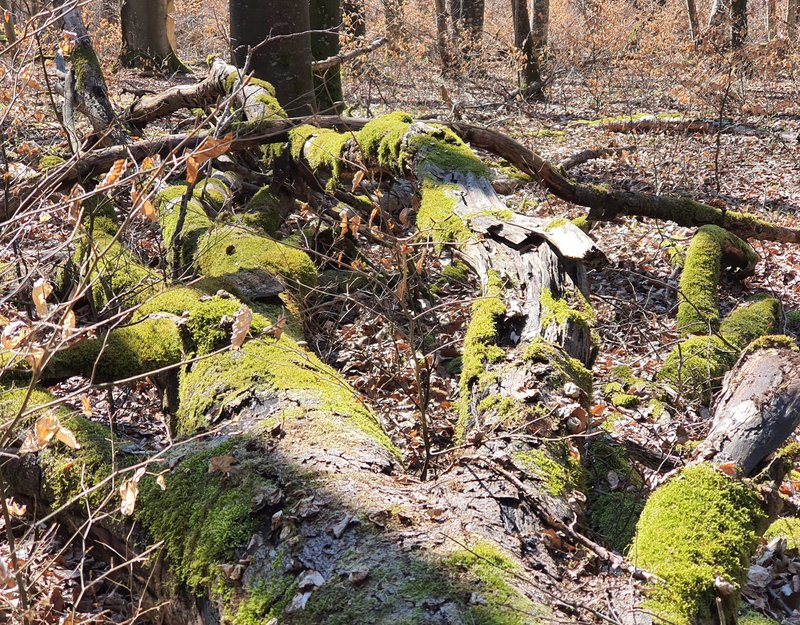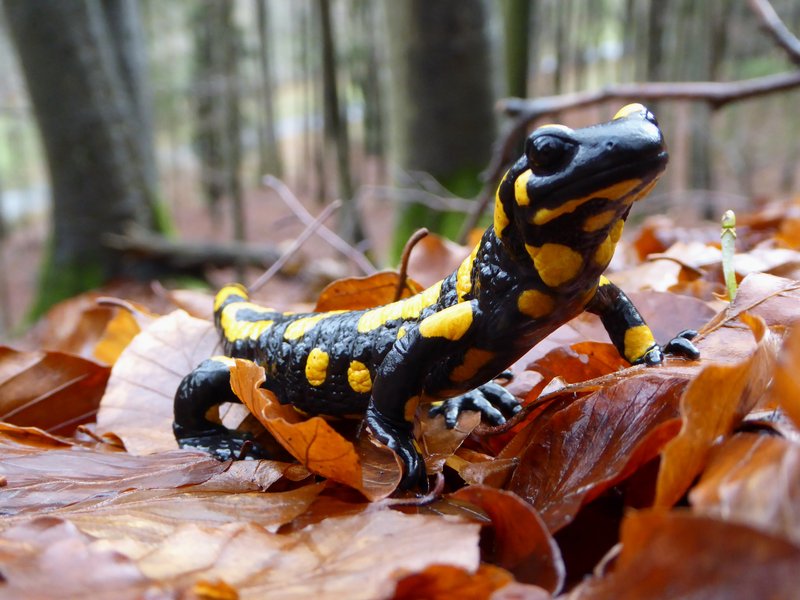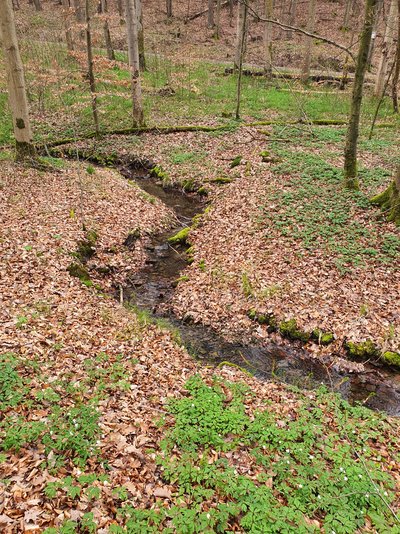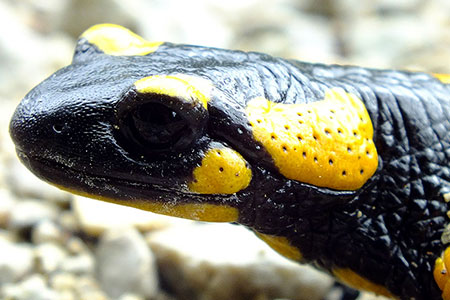Of the 19 amphibian species native to Bavaria, the fire salamander is the one most closely associated with the forest. Forest owners in particular can thus do much to help the cave animal of the year 2023. Ways must be found to preserve and optimise the habitat of the fire salamander. Particularly important for this species is a closely interlinked habitat complex of near-natural deciduous and mixed forests and structurally rich streams and stream catchment areas.
Features such as lying deadwood, upturned rootstocks, brushwood and piles of stones enrich the forests. By leaving them, forest owners can for example increase the availability of refuges for this species. Timber harvesting and logging should be carried out with extreme care in salamander areas, and the upper reaches of streams in particular should remain untouched and rich in structure. Potential winter quarters (piles of branches and stones, thick dead wood, loose rock, crevices in slopes, etc.) should also remain untouched.
Timber harvesting and skidding should be carried out in late autumn and winter, as this is when most animals have moved to their winter quarters. In principle, fire salamanders are active all year round if the temperatures are not too low. They can be found at temperatures above 2 °C at night and with sufficient humidity.
A fire salamander is an impressive sight. With its shiny black and yellow-spotted skin and length of up to 20 cm, this amphibian is so conspicuous that even amateurs can recognise it immediately.
Two subspecies: striped and spotted
Two subspecies occur in Germany. The striped fire salamander - the western subspecies Salamandra salamandra terrestris - has two yellow lines on its back, which are usually interrupted several times. By contrast, the spotted salamander - the eastern subspecies Salamandra salamandra salamandra - is irregularly spotted. Bavaria lies in the transitional zone where the ranges of the two subspecies meet.
The fire salamander is widespread across large parts of central and southern Europe. As a significant proportion of the global population is found in Germany, the fire salamander is one of the species for which Germany holds particular responsibility, in accordance with the “National Strategy on Biological Diversity”. Its typical habitat is moist deciduous and mixed deciduous forests in the low mountain ranges. Its distribution pattern in Bavaria is therefore correspondingly patchy. Fire salamanders are mainly found in the northern Franconian deciduous forest areas and in forests rich in deciduous species in south-eastern Bavaria (Bavarian Forest, Alpine foothills and Alpine region), where the species colonises habitats at altitudes of up to 1000 m. Because it needs caves, tunnels and other underground cavities as a refuge, it was chosen as Cave Animal of the Year 2023, representing many other species that rely on such structures.
Little is known about the migration of fire salamanders. The majority of animals of this species found migrating in spring appear to be females. Concrete information on migration distances is largely lacking. It can be assumed that these can vary considerably. Distances of 500 metres or even further are possible.
Of all our native amphibians, the fire salamander is the animal most closely associated with forests, especially beech and mixed beech forests. However, it can also be found in other moist forests rich in deciduous trees, such as ravine forests. It is important that the forests offer many structures that are suitable as refuges. These include dead wood, tree stumps, gap systems in the ground such as passages made by small mammals, rock crevices or caves.
This amphibian leads a hidden existence. Because of its sensitive skin, it only leaves its hiding place when humidity is high, i.e. usually at night or in rainy weather. It mainly preys on earthworms, slugs, caterpillars, beetles and spiders.
Adult animals are not necessarily dependent on surface water. The females only seek out near-natural, oxygen-rich and fish-free water bodies to deposit their larvae. These are usually shallow water areas with little current in springs, spring pools or the upper reaches of forest streams - occasionally tyre tracks or other standing forest water bodies.
Offspring born live
The fire salamander is unusual in the native amphibian world in that the female fire salamander does not spawn in the water, but instead releases live larvae. This happens in spring - usually in March - over the course of several nights. A female releases between 10 and 70 “mini-salamanders”, 2.5 to 3 cm long, into the shallow water. The larvae spend around three months there. They initially breathe via external gills, but leave the water breathing with their lungs after metamorphosis.
The amphibians can become very old. There is evidence of 20-year-old animals in the wild - in terrariums they can even reach 50 years of age. One reason for its long life expectancy could be the poisonous skin secretion that the salamander secretes from its ear and dorsal glands when in danger. It probably tastes extremely unpleasant and triggers salivation, nausea and even convulsions in other animals. The number of predators is therefore limited for adult animals. The situation is different with the non-poisonous larvae. These are eaten by dragonfly larvae, fish, water shrews, dippers and blackbirds, among others. The poison is relatively harmless to humans. On contact, it only causes skin irritation and stinging eyes.
The fire salamander is specially protected in Germany in accordance with the Federal Species Protection Ordinance and the Federal Nature Conservation Act. On Germany’s Red List it is categorised as “not threatened”, and in Bavaria as “threatened”. The long-term development trend for the fire salamander is estimated to be negative. The main reason for this is the skin fungus Batrachochytrium salamandrivorans – “Bsal” or “salamander plague” for short. The fungus was accidentally introduced to Europe with amphibian imports from Asia. It only attacks tailed amphibians of the Caudata group. Frogs and toads are not known to be infected, but they can act as vectors.
The infection leads to superficial lesions, but also to deep ulcers in the skin, which then develop secondary bacterial infections. Infected fire salamanders die quickly, often within a week. In 2010, the infection almost led to the extinction of the fire salamander population in the Netherlands and Belgium.
Skin fungus also jeopardises the Bavarian population
Since then, the fungus has continued to spread and it finally reached Bavaria in 2020. Unfortunately no effective countermeasures are known to date, so the main aim is to prevent or at least slow down the further spread of the fungus as far as possible.
To reduce the risk of infection and spread in the affected regions (in Bavaria currently the Steigerwald forest and Unterallgäu region), amphibians should therefore not be touched, forest visitors should stay on surfaced paths, and dogs should not be allowed to run around freely. In addition, people should stay away from water bodies of all kinds and their banks when in the forest.
Species support programme in Bavaria
In 2021, a species assistance programme was initiated for the fire salamander in Bavaria, funded by the Bavarian Ministry of the Environment. The sponsors are the conservation association Bund Naturschutz, the Bavarian association for the protection of birds and nature (Landesbund für Vogel- und Naturschutz), and Bavarian association for the protection of amphibians and reptiles (Landesverband für Amphibien- und Reptilienschutz). The aim is to count larvae in eight known Bavarian spawning grounds until August 2024 in order to gain an overview of the current situation of the species and to recognise any dramatic falls in the population (especially against the background of the “salamander plague”) at an early stage. Specific conservation measures are also planned for the species, such as the renaturalisation of springs and stream headwaters or the creation of pools through the introduction of deadwood.




